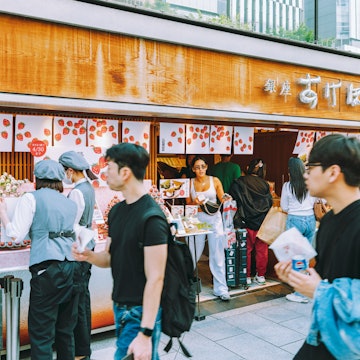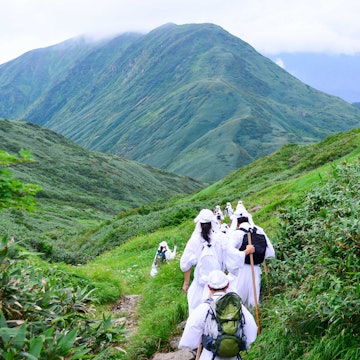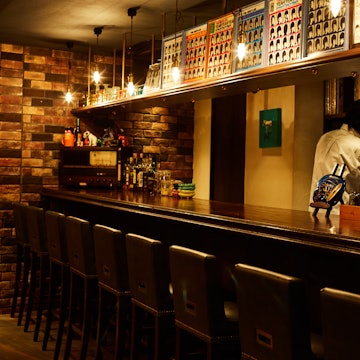

Visiting an onsen during winter is particularly beautiful when they're outdoors. Getty Images
Bathing in an onsen gives you a glimpse into a millennium-old Japanese tradition and ritual. Locals of all ages come to relax the mind and body with friends or for peaceful solitude. Literally meaning "hot spring", an onsen visit is a vital experience in Japan.
An "onsen" refers to the hot spring and its attached facilities. These might be within a hotel or ryokan (traditional Japanese inn) or grouped with other onsen in a mineral-rich town. Onsen can range from luxurious modern baths to steaming outdoor pools carved into an exquisite Japanese garden.
There are strict rules of etiquette surrounding a visit to these relaxing springs, which might be daunting for first-time visitors. This guide walks you through each stage of your visit and all the required etiquette to help you experience an onsen like a local.

Arriving at an onsen in Japan
When you enter an onsen, leave your shoes in a locker or on a designated shelf. Pay the entrance fee (usually between ¥400-800/US$2.67-5.34 Japanese yen but up to ¥2000/US$13.35) to a person at a counter or a vending machine for tokens. Large and small towel rental is either included or costs extra (about ¥300/US$2). Then head to the changing area. Men and women bathe separately, so look for the characters 男 for male and 女 for female on door curtains to avoid embarrassment. Men's curtains are usually blue; women's are red.
In the changing rooms, you’ll find baskets or coin lockers in which to store all your belongings, a large towel and, after undressing, your clothes – even your underwear. Yes, it's routine to get completely naked. Jewelry can get stained by the bath's minerals, so leave that behind too. All you should be left wearing is an optional small towel and a waterproof locker bracelet. If you have bathing toiletries, you can bring them along. Changing rooms usually provide a hairdryer and other basic amenities such as razors, lotions, perfumes and colognes.
Scrub up before soaking
Once in the buff, move into the onsen bathing area. Facing the baths cloaked in rising steam you’ll find open shower cubicles or wash troughs lining the walls. Sit on a stool facing the wall and use the small bucket, soap and shampoo provided to wash yourself thoroughly from head to toe. The onsen is not for washing yourself in, so make sure you are sparkling clean and soap-free before getting in. Find the toilets first, if you need to go. This all keeps the bathwater pristine and inviting for everyone. Watch your step, the floors are wet and can be slippery.

How to soak in a hot spring bath
Public onsen have at least one main bath with steps to enter or sit on. Some have various baths, each fed by natural spring water. Choose yours carefully. Maybe not the one with the lightning bolt symbol above it, unless a mild electric shock thrills you – the theory is that electricity contracts the muscles, which leads to relaxation once you jump out. Be careful also of the scalding bath – you’ll know it the moment you dip your pinkie in.
Start instead with one of the regular hot baths (34-42°C/93-107°F), entering slowly to test the temperature. Steps can be hidden under milky water too. If there are other bathers, there’s no need to say a word or make eye contact, just enjoy. Stay in the soothing warmth for as long as you like. Leave after a minute or soak for hours. Some people will get out, take five on a rock or the bath edge, and then get in again. Relax and forget the stresses of the modern world outside for a blissful period.
After soaking away your tension in the hot waters, you might feel daring enough to dip into the icy cold bath to snap you out of drowsiness. Some onsen also have an extra mineral-rich bath with a water color that varies depending on the minerals it contains. Iron-rich onsen water can appear dark reddish-brown, while iodine onsen water has a straw color and a distinct smell.
Now step out and repeat the process, washing yourself again on a stool, then sinking into another bath – this is the centuries-old ritual of onsen.
Finishing up at an onsen
When you're ready to leave, go Japanese style – don’t wash off the minerals of your last dip. Pat down with the small towel before going to the changing room to keep the floor splash-free. Then dry off completely with your large towel and get changed into your clothes or pajamas.
Some onsen offer amenities such as massage services for an additional fee and relaxation lounges where you can rest before or after your bath.

Naked and free
Everybody bathes completely in the buff at an onsen. It's just you and the water – no swimsuits or underwear are allowed. For newbies, it can help to know that Japanese people feel completely at ease with this nudity and won't pay (overt) attention to you, foreigner or not. Bathers keep to themselves the same way they do alongside strangers on public transport in Japan.
With this knowledge, and doing as the Japanese do, the experience can feel liberating and natural amongst the shrouding steam. Communal bathing in Japan is viewed as a great social leveler for its power of hadaka no tsukiai (naked friendship).
You can try to use your tiny scarf-like towel to cover yourself as you move between pools, but don't let it touch the water. To keep it from contaminating the baths, fold it and balance it on your head like the pros do.
Not interested in getting naked with strangers? In onsen ryokan, there is usually the choice of an intimate kashikiri onsen room (a private space but the pre-cleansing routine still applies) or rotemburo (outdoor bath) with scenic views just for you and your special somebody.
Onsen etiquette
Onsen are peaceful retreats. Speak softly and avoid making loud noises or splashing about to maintain the serene ambiance. Swimming and submerging your head will earn you dirty looks. People with long hair should tie it up before stepping into the bath.
Some onsen do not allow entry to bathers with visible tattoos due to associations with organized gangs in Japan. Check the policy or cover your tattoos with waterproof tattoo-covering stickers (sometimes provided by hotel onsen), if needed.

When should I visit an onsen?
Each season offers its own unique onsen charm. Spring (March to May) cherry blossoms and fall leaves are popular for bathing in outdoor baths with picturesque backdrops. Winter (December to February) is a dramatic time to visit an onsen, especially where there is heavy snowfall – the hot springs create a dramatic contrast against a snowy wonderland.
It's no wonder that winter is when many onsen festivals take place. For budget travelers, the least crowded and most affordable times are typically in late winter (January to early March) and early autumn (late September to early October). The busiest and most expensive periods are the holidays of Golden Week (late April to early May), Obon (mid-August), and the New Year (late December to early January).
How much time should I spend at an onsen?
A visit to an onsen can be as brief as five minutes or as leisurely as a whole afternoon. For a day trip to an onsen town, plan to spend at least a few hours to fully enjoy the experience. Add extra time for lounging in on-site saunas and relaxation areas. If you have a weekend to spare, consider staying at a ryokan with its own onsen facilities. This allows you to experience the onsen at different times of the day, for serene early morning bathing and tranquil evening hours. Onsen towns are often set in nature with hiking and temple visits for a deeper immersion into the cultural and relaxation experience.

The best onsen in Japan
This is our pick of the best onsen across the country.
Rendai-ji’s Kanaya Ryokan, Hakone: The wooden onsen bath on the Izu Peninsula is enormous, atmospheric and offers mixed bathing.
Nakabusa Onsen, The Japan Alps: Amazing and remote onsen with 29 natural hot springs.
Kurama Onsen, Kyoto: An ideal spot to soak away city pressures or to relax after a hike in the nearby hills.
Kinosaki, Kansai: The ultimate onsen town, featuring seven public baths and numerous onsen ryokan.
Lamp no yado Aoni Onsen: Cradled in a remote valley, this ryokan and onsen are illuminated solely by oil lamps, creating a serene soaking experience.
Tsurunoyu Onsen, Nyūtō: Dip into the milky, mineral-rich baths of on onsen that has been operating for four centuries.
Fukiage Roten-no-yu, Central Hokkaidō: Way off the beaten track, the forest-surrounded konyoku (mixed bathing) onsen is wonderfully natural – as a bonus, it’s free.
Dōgo Onsen, Matsuyama: Since the castle-like building’s construction in 1894, this onsen has been featured in ample literary classics, most notably in Natsume Sōseki’s Botchan.
Ibusuki, Kyūshū: Beppu attracts onsen tourists, but for a unique experience, visit the renowned sand baths of Ibusuki where onsen steam rises through the sand, enveloping bathers buried up to their necks.
Hirauchi Kaichū Onsen, Yakushima: For the adventurous, this outdoor, seaside pool offers minimal privacy unless you get lucky and snag it to yourself. But at under ¥300 (US$2), the stunning setting is unbeatable.
















